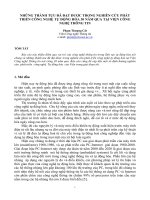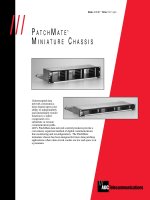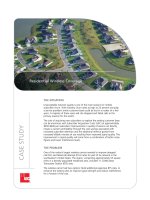Tài liệu Residential Wireless Coverage pptx
Bạn đang xem bản rút gọn của tài liệu. Xem và tải ngay bản đầy đủ của tài liệu tại đây (180.64 KB, 2 trang )
CASE STUDY
Residential Wireless Coverage
THE SITUATION
Unacceptable network quality is one of the main reasons for mobile
subscriber churn. With industry churn rates as high as 25 percent annually,
a service provider’s entire customer base could be lost in a matter of a few
years. A majority of these users will cite dropped and failed calls as the
primary reasons for the switch.
The cost of acquiring new subscribers to replace the existing customer base
can be enormous with Subscriber Acquisition Costs (SAC) at approximately
$350-$400 per subscriber. Improvements in quality of service can directly
impact a carrier’s profitability through the cost savings associated with
increased subscriber retention and the additional revenue gained from
increased billable minutes of use resulting from improved signal quality. This
improvement in signal quality will come from a combination of better noise
figures and lower interference levels.
THE PROBLEM
One of the nation’s largest wireless carriers wanted to improve dropped
call (DC) and failed call attempt (FCA) rates for part of its network in the
southeastern United States. The region, comprising approximately 53 square
miles in a densely populated residential area, included 11 CDMA Base
Transceiver Station (BTS) sites.
The wireless carrier had two options: Build additional expensive BTS sites, or
enhance the existing sites to improve signal strength and reduce interference
for a fraction of the cost.
Web Site: www.adc.com
From North America, Call Toll Free: 1-800-366-3891 • Outside of North America: +1-952-938-8080
Fax: +1-952-917-3237 • For a listing of ADC’s global sales office locations, please refer to our Web site.
ADC Telecommunications, Inc., P.O. Box 1101, Minneapolis, Minnesota USA 55440-1101
Specifications published here are current as of the date of publication of this document. Because we are continuously
improving our products, ADC reserves the right to change specifications without prior notice. At any time, you may
verify product specifications by contacting our headquarters office in Minneapolis. ADC Telecommunications, Inc.
views its patent portfolio as an important corporate asset and vigorously enforces its patents. Products or features
contained herein may be covered by one or more U.S. or foreign patents. An Equal Opportunity Employer
104322AE 3/07 Original © 2007 ADC Telecommunications, Inc. All Rights Reserved
CASE STUDY
THE ADC SOLUTION
The wireless carrier turned to its longtime business partner, ADC, for help. Network technicians analyzed
a cluster of 11 BTS sites for a two-week period. Each BTS site included a three-sector, diversity tower
with the average height of each tower at 180 feet. Dropped Call (DC) and Failed Call Attempt (FCA)
data was gathered on each sector of each tower.
DC and FCA rates were unacceptable for many of the BTS sites within the cluster. In fact, field tests
revealed that more than five percent of all mobile calls in the region experienced service failure—with
some areas reporting service loss as high as 10 percent. Insufficient uplink sensitivity at the base station
was deemed to be responsible for the reduced signal strength throughout the coverage areas. There did
not appear to be significant interference issues at most of the BTSs.
Since CDMA can be both uplink and downlink limited and ADC has shown that the use of a tower
mounted amplifier can improve both the capacity and the coverage of each BTS*, technicians installed
ClearGain
®
Tower-Mounted Amplifiers (TMAs) as close as possible to each receive antenna on the
towers. The ClearGain TMAs reduced the composite Noise Figure, which increased the uplink signal
sensitivity of each BTS site. This, in turn, resulted in:
An increase in the allowable path loss (and therefore coverage area), or
An increase in capacity for a fixed coverage area, or
A reduction in mobile transmit power for a given coverage/capacity combination, which resulted in
longer mobile phone battery life.
BENEFITS REALIZED BY CUSTOMER
Technicians tabulated DCs and FCAs for two weeks after the TMAs were installed. Representatives
from the wireless carrier were ecstatic with the results—as were their customers.
The ClearGain TMAs were estimated to expand service coverage area by up to 40 percent. Signals were
able to reach users on the outermost areas of the region, even during periods of intense demand, e.g.,
weekday rush hour. As a result, the number of DCs decreased by approximately 21 percent after the
ClearGain installation. The number of FCAs also decreased by approximately 21 percent.
Mobile phone users in the region can now place more calls, make longer calls and successfully complete
more calls in an expanded geographic area. As a result, the wireless carrier has minimized customer
churn and maximized revenue opportunities.
*Reference ADC white paper "CDMA Coverage and Capacity" by Dr. Phil Wala, 17 October, 2006.
1.
2.
3.









